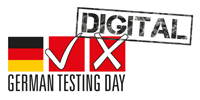
Konferenzprogramm
Die im Konferenzprogramm des GTD digital 2021 angegebenen Uhrzeiten entsprechen der Central European Time (CET).
Per Klick auf "VORTRAG MERKEN" innerhalb der Vortragsbeschreibungen können Sie sich Ihren eigenen Zeitplan zusammenstellen. Sie können diesen über das Symbol in der rechten oberen Ecke jederzeit einsehen.
Gerne können Sie die Konferenzprogramm auch mit Ihren Kollegen und/oder über Social Media teilen.
Der Track+ besteht aus Präsentationen der Sponsoren und unterliegt somit nicht der Qualitätssicherung des Conference Boards.
Bitte beachten Sie, dass es für vereinzelte Workshops eine Teilnehmerbeschränkung gibt. Weitere Infos hierzu finden Sie in den Workshop-Beschreibungen.
Konferenzprogramm 2021
Thema: Test Automation
- Montag
03.05. - Dienstag
04.05.
Self-Healing Tests ist ein Ansatz, bei dem maschinelles Lernen bei der Wartung von automatisierten Tests hilft.
Self-Healing, die Automation der Testautomation, erkennt Änderungen im 'System under Test' und passt die Testdurchführung automatisch an, damit die Tests funktionsfähig bleiben. Kommerzielle Tools, wie TestIM und Tricentis Neo Engine, sind vielversprechend und rechtzeitig auf den Zug aufgesprungen. Es gibt aber auch vielversprechende Open-Source Alternativen, wie Healenium.
Dieser…
You're tasked to work on an existing test automation suite, and you note usual problems:
- Slows down the development process
- Test addition is an afterthought in the dev cycle
- Doesn't point to the problem area in code on failure
- Doesn't actually give you regression confidence
- Rely on just one person to fix or run it (you!)
- Tests get or 'are tagged to be' ignored
You need help. And the help you need is not creating a new framework, but rather learning to tidy it up so that instead of problems, your tests…
Raiffeisen Bank International (RBI) started in 2017 with “Group Digital Solutions” a journey in order not to oversleep the digitization of the banking industry.
Due to new approaches such as DevSecOps & Continuous Testing, the topic of software tests, whether manual or automated, had to be completely redesigned and implemented.
This talk gives insights into the test strategy & the fullstack test automation architecture that were used.
Target audience: testers, developers, architects, managers
Pr…
